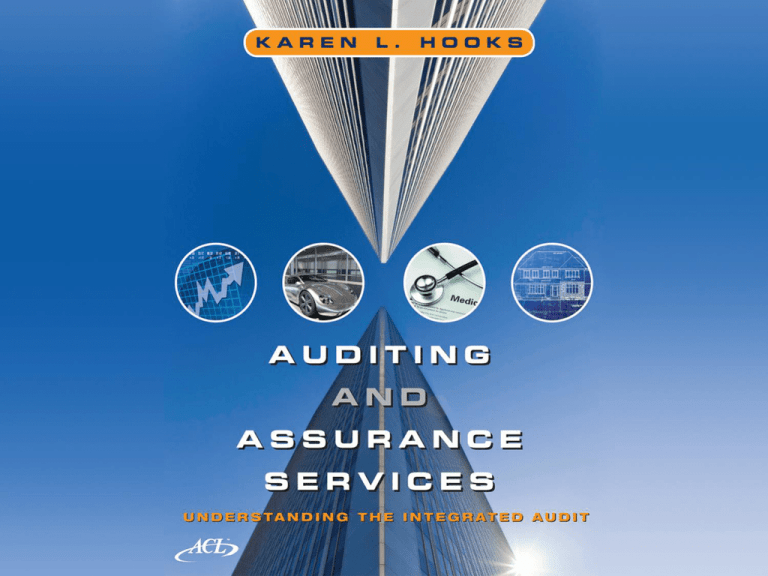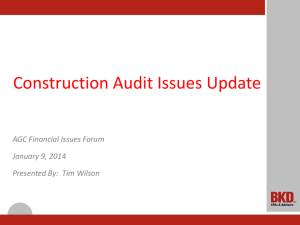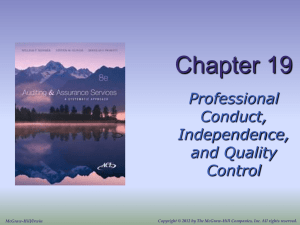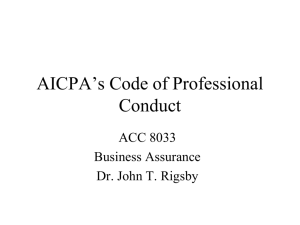
Chapter 3
The Auditor’s Role in Society
Learning Objectives
1. Describe the contributions audit services make to society and
relationships among auditors, audit clients and the public.
2. Describe the different inputs to and influences on personal
ethics and morals.
3. Understand the role and contributions of professionals in
society.
4. Recognize the potential for ethical considerations and outcomes
in decisions and the decision-making models applicable to
ethical decisions.
5. Become familiar with external regulation and professional
standards governing the accounting profession’s conduct and
quality control.
Auditors as Professionals
Professionals
Make a living by providing services to others
Recipients of professional services have to trust the
professional because they do not have the knowledge
that would be needed to monitor the quality of work
Auditors
Are different from most professionals because their
services benefit the public but their compensation for
the services does not come from the public
Constituents of Auditors’ Services
The public and capital markets are the ultimate
beneficiaries
As owners of the company being audited, the
shareholder group is actually the client
The shareholders elect the Board of Directors to
oversee the company for them
As a committee of the Board of Directors, the Audit
Committee is a subset of the board of directors
The Audit Committee selects and hires the auditors,
oversees the auditor’s compensation, and interacts with
the auditors
Examples of Different Philosophies
What is right? It depends on the philosophical
underpinning…
Whatever creates the greatest good
Whatever is fundamentally “right,” regardless of
consequences
Whatever preserves the life of even one person
The decision made by a single ruler with ultimate
authority
The decision made by the group of people affected
Whatever the law requires
Theory of Moral Development
Pre-conventional level: completely self-
centered decisions
Conventional level: considers impacts
beyond personal consequences;
considers others
Post-conventional level: abstract
analysis of right and wrong
Food for thought
Accountants and auditors must behave at a
conventional level when performing their work. If
they were to behave in a post-conventional manner
they would apply abstract analysis and decide that
their preferences were “right.” If accountants and
auditors used personal preferences instead of
following the standards set according to due
process, financial statements would lose
comparability.
Ethical Orientation
Ethic of Rights
Business
Laws
Courts
United States culture
Ethic of Care
Family
Sports teams
Military
Pacific Rim and other cultures
Sociology of Professions
Entry and membership in the group
Regulation
Self regulation
Coordination with authorities
Individual characteristics
Taxonomic description
Technical expertise
Integrity
Believe their work is of value, important
Believe they make a contribution through their work
Social contract
Auditing is a Profession
A profession is an occupational group of individuals with a
collective identity
Body of knowledge: accounting and auditing
Community of peers: AICPA and other groups
Entry and Membership: CPA exam, continuing education
Regulation of the group: AICPA is internal; SEC, PCAOB, states
and courts are external
Individual Characteristics: competence, integrity
Social Contract: oversight of the quality of financial reporting
provided to the public in exchange for professional status
Decision Process for Moral Issues
Environment produces issues with moral components
Decision maker recognizes the moral issue or moral components. Moral
intensity affects whether the decision maker recognizes the moral
components.
Magnitude of the consequences
Social consensus
Probability of effect
Temporal immediacy
Proximity
Concentration of effect
Decision maker goes through a decision process to make a judgment
regarding the issue, and selects and carries out a behavior. This is done
using a decision model that considers ethical consequences.
Model for Making Ethics-Related Decisions
Determine the facts of the situation.
Identify the ethical issues and people involved. Who are the
stakeholders?
Identify the values related to the situation: honesty, loyalty,
compassion, integrity, etc. Identify any that conflict.
Identify alternative courses of action that are available.
Evaluate courses of action and match each with relevant
values.
Consider the consequences of viable courses of action
remaining.
Make the decision; take indicated action.
Value of Using an Ethics Decision Model
Supports considering ethics during the decision
making process
Does not guarantee a particular decision result
Moral dilemmas will still exist; this type of
decision model just helps provide a process for
addressing them
A moral dilemma is an ethics-related
situation for which there is no clear right or
wrong answer
AICPA Code of Conduct
Principles of Professional Conduct
Conceptual, ideal standards; not enforceable
Rules of Conduct
Threshold for minimum acceptable behavior
Stated in behavior-related language
Enforceable
Interpretations of the Rules of Conduct
Response when there are frequent questions about a rule
Departures must be justified in any disciplinary hearing
Rulings by the Professional Ethics Executive Committee
Rulings on individual cases; responses to specific factual circumstances
Justification for departures may be requested in any disciplinary
hearing
Principles
Responsibilities
Professional and moral judgment
Public interest
Integrity
Objectivity and Independence
Conflict of interest
Public practice; attest functions, independent in fact and
appearance
Due Care
Scope and Nature of Services
Observe the other principles in making these decisions
How AICPA Rules Use the Term “Public Practice”
What does it mean to be in public practice?
…covered in the definitions
Performance for a client by a member or a member’s firm,
while holding out as a CPA, of the professional services of
accounting, tax, personal financial planning, litigation support
and professional services for which standards are promulgated
by bodies designated by Council.
Council is the AICPA’s Council
For example, standards referred to are: SFAS, SAS, SSARS,
SSCS, SSAE – and now also IFRS and ISA
AICPA Code, Rules
Rule 101 - Independence
Rule 102 – Integrity and Objectivity
Be objective
Behave with integrity
Don’t misrepresent facts
Don’t subordinate judgment
Rule 201 – General Standards
Professional competence
Due professional care
Planning and supervision
Sufficient relevant data
Rule 202 – Follow the rules
Rule 203 - Financial statements have to be GAAP to issue a clean opinion
unless the exception applies
AICAP Code, Rules continued
Rule 301 - Confidential client information
Exceptions: subpoenas, practice monitoring, complaints regarding professional
performance
Rule 302 - Contingent Fees
Rule 501 – Acts Discreditable
Rule 502 – Advertising & Other Forms of Solicitation
False, misleading, deceptive, coercion, overreaching, harassing
Rule 503 –
Can’t recommend anything to (attest) client if you get a fee for it
Can’t recommend anything an attest client does or sells to anyone if you get a
fee from the attest client
If you are allowed to, and receive a commission, have to disclose it to the person
to whom you make the recommendation
Referral fees; if you pay or receive a referral fee have to disclose it to the client
Rule 505 – Form of Practice and Name
Only an allowed organizational form
Name that is not misleading
All owners have to be AICPA members to say the firm is: “Member of AICPA”.
Definitions
The following terms have specific definitions for the
AICPA Code of Professional Conduct:
Attest engagement
Interpretation
Professional services
Attest engagement team
Key position
Significant influence
Client
Loan
Close relative
Key position
Council
Loan
Covered member
Manager
Financial institution
Member
Firm
Normal lending procedures
Holding out
Office
Immediate family
Partner
Individual…position to influence Period of the…engagement
Institute
Practice of public accounting
Conceptual Framework, AICPA Independence
ET 100.01…a member’s relationship with a client is
evaluated to determine whether it poses an
unacceptable risk to the member’s independence. Risk
is unacceptable if the relationship would compromise
(or would be perceived as compromising by an
informed third party having knowledge of all
relevant information) the member’s professional
judgment when rendering an attest service to the
client.
Independence
In fact and in appearance
General SEC guidelines communicate the essence of
independence
SEC General Standard of Auditor Independence
No mutual or conflicting interest with the audit client
Audit firm cannot audit its own work
Audit firm cannot act as management
Audit firm cannot be an advocate for the client
In 2001 SEC relaxed the group of people to whom
independence rules apply
AICPA Interpretation 101 of Rule 101
Independence shall be considered to be impaired
if:
A. During the period of the professional engagement a
covered member…
Definitions, Important for Covered Member
Individual: the person or the person’s immediate
family
Immediate family: spouse, spousal equivalent,
dependent (whether or not related)
Attest engagement team: Individuals participating in
the attest engagement, including those who perform
concurring and second partner reviews, regardless of
functional classification (audit, tax, consulting).
Excludes specialists and those performing clerical
tasks.
Definitions, Important for Covered Member
An individual in a position to influence the audit engagement;
Someone who
Evaluates the performance or recommends the compensation
of the attest engagement partner
Directly supervises or manages the attest engagement
partner (all the way up to firm’s chief executive)
Consults with the attest engagement team on technical or
industry-related issues specific to the attest engagement
Participates in or oversees quality control activities with
respect to this attest engagement (all the way up to the top
of the firm)
A Covered Member Is….
An individual on the engagement team
An individual in a position to influence the
engagement
A partner or manager who provides 10 or more
hours of nonattest services to the client
Another partner in the office of the lead attest
engagement partner
The firm, including the firm’s employee benefit plans
Any entities whose policies are controlled by any of
the people described above
AICPA Interpretation 101
Important terms:
Financial interest: direct financial interest, material indirect financial interest
Management role
Family: immediate, close
Period covered by the audit, period of the professional engagement
Financial interests that are problems:
Have direct or material indirect interest
Be a trustee or executor of an entity with a direct or material indirect interest
Have joint investment
Have a loan through other than normal lending procedures
Cannot own more than 5% of the client either together or in a group (even if it is
not material and indirect)
Applies to CPAs doing the audit and people who previously worked for the client;
Someone who worked for client and moves to audit firm can sever financial ties
AICPA Interpretation 101 continued
Control positions/functions that are problems
Director
Officer
Management or equivalent
Promoter
Underwriter
Voting trustee
Pension or profit sharing trustee
Works in both directions
CPA performing those services for the client
Person in a client control position coming to work for the CPA firm and
auditing the period they perform the control function.
Close Relatives
Close relative – only independence problems
When close relative is in a key position, or
Has a financial interest that is material to the close relative
that the auditor knows about that can result in significant
influence over the client
in a key position means…
Significant accounting function
Preparation of financial statements
Ability to exercise influence over the contents of the financial
statements
Can influence an attest engagement that is not about the
financial statements
Immediate Family, Close Relatives
Differences exist for independence issues when
immediate family and close relatives are involved
Covered member is expected to know everything about
immediate family
Financial interests and employment of immediate family
can cause independence problems
Employment of close relative in key position is visible, so
covered member knows about it
Finances of close relative can only be a problem if the
covered member has knowledge
Public Company Issues
Sarbanes Oxley 1 year cooling off period (Section 206, Conflicts of Interest)
Services that impair independence: SEC, SOX
Bookkeeping
Systems design and implementation
Appraisal or valuation services
Actuarial services
Internal audit outsourcing services
Management functions
Human resources
Broker-dealer, investment adviser, investment banking services
Legal services
Expert services unrelated to the audit
Note: Not all of these would be prohibited by AICPA rules
Fees paid to the audit firm for non-audit services must be disclosed in the proxy
statement
Audit Committee Approvals
Under SOX
Audit committee hires the auditor, and as a
result, approves the audit service
Audit committee approves any other services
If a non-audit service is not prohibited it
must be approved in advance by the
client’s audit committee
Peer Review
AICPA
Peer Review Program (AICPA PRP)
National Peer Review Committee
Reviews the portion of a firm’s practice not inspected by
the PCAOB
PCAOB
Firm Registration
Inspections
International Code of Ethics
International Federation of Accountants
International Ethics Standards Board for Accountants
(IESBA)
Code of Ethics for Professional Accountants
Applicability of IESBA Code
CPAs must comply with the standards of
the applicable jurisdiction, or most
restrictive code
IESBA Code revised in July 2009,
effective January 1, 2011
CPA Exam coverage of IESBA Code could
begin effect January 2011
Structure of IESBA Code
Set up in 3 sections
Part A, General Application of the
IESBA Code
Part B, Professional Accountants in Public
Practice
Part C, Professional Accountants in
Business
Conceptual Framework, IESBA
Uses a Conceptual Framework approach
Identify threats to compliance with the
fundamental principles
Evaluate the significance of the threats
identified
Apply safeguards, when necessary to
eliminate threats or reduce them to an
acceptable level
Fundamental Principles, IESBA
Integrity
Objectivity
Professional Competence and Due
Care
Confidentiality
Professional Behavior
Threat Categories, IESBA
Self-interest threat
Self-review threat
Advocacy threat
Familiarity threat
Intimidation threat
Some of these look familiar – AICPA, SEC
Safeguards, IESBA
Safeguards created by the
profession, legislation or regulation
Safeguards in the work environment
Safeguards: Professional, Legislation, Regulation
Educational, training and experience requirements
for entry into the profession
Continuing professional development requirements
Corporate governance regulations
Professional standards
Professional or regulatory monitoring and
disciplinary procedures
External review by a legally empowered third
party
Other Safeguards
Safeguards to identify or deter
Effective, well-publicized compaint systems
Explicitly stated duty to report breaches of ethical
requirements
From the work environment
Presented in Parts B and C
These are the details of Parts B and C – what CPAs
should and shouldn’t do
AICPA, IESBA
An example of differences between the Codes:
Addressing familiarity threats, these examples are
not addressed directly in AICPA Code:
Long Association of Senior Personnel (Including Partner
Rotation) with a Client
Fees-Relative Size
Copyright
“Copyright © 2011 John Wiley & Sons, Inc. All rights reserved.
Reproduction or translation of this work beyond that permitted
in Section 117 of the 1976 United States Copyright Act without
the express written permission of the copyright owner is
unlawful. Request for further information should be addressed
to the Permissions Department, John Wiley & Sons, Inc. The
purchaser may make back-up copies for his/her own use only and
not for distribution or resale. The Publisher assumes no
responsibility for errors, omissions, or damages, caused by the
use of these programs or from the use of the information
contained herein.”







